SA-4 Report: Research Methods, Data Analysis, and Ethical Concerns
VerifiedAdded on 2020/03/07
|10
|2144
|59
Report
AI Summary
This report, titled SA-4, delves into the critical evaluation of research tools and methods, focusing on an article examining the impact of human resource practices. The report dissects primary research methods, specifically survey techniques employing Likert scales and open-ended questions, and analyzes the strengths and weaknesses of secondary research methods, such as journal articles. It proposes alternative methodologies for data analysis, like Cronbach's alpha, and data collection, suggesting questionnaires and focus groups. The second part of the report outlines a causal research approach to investigate the relationship between employee motivation and retention, detailing data collection through primary and secondary sources, sampling strategies, and research tools like questionnaires and SPSS software. It also explores alternative research methods like observation and focus groups. Furthermore, the report includes feedback on research methodologies to two colleagues and addresses ethical concerns related to data collection and usage, emphasizing informed consent, confidentiality, and proper acknowledgment of sources.
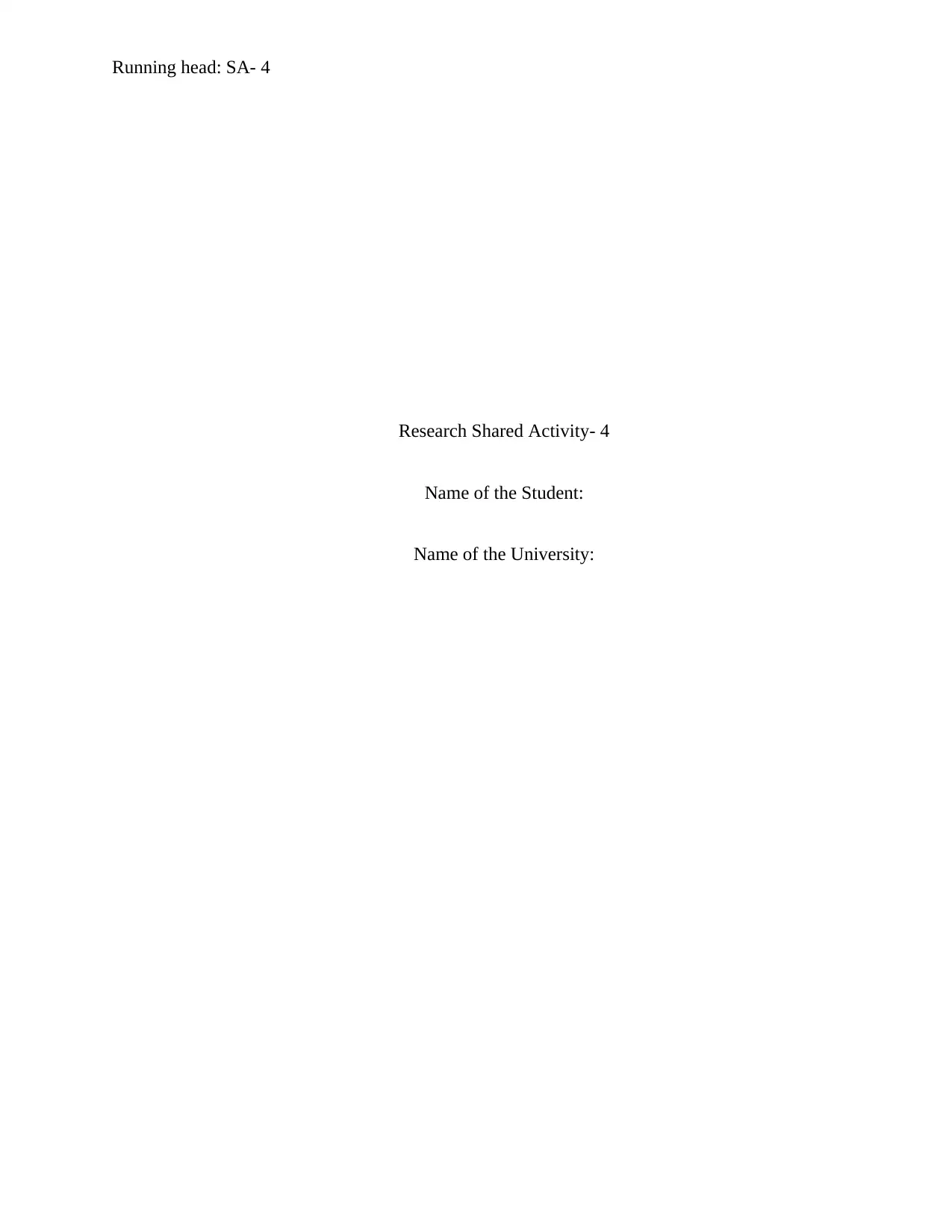
Running head: SA- 4
Research Shared Activity- 4
Name of the Student:
Name of the University:
Research Shared Activity- 4
Name of the Student:
Name of the University:
Paraphrase This Document
Need a fresh take? Get an instant paraphrase of this document with our AI Paraphraser
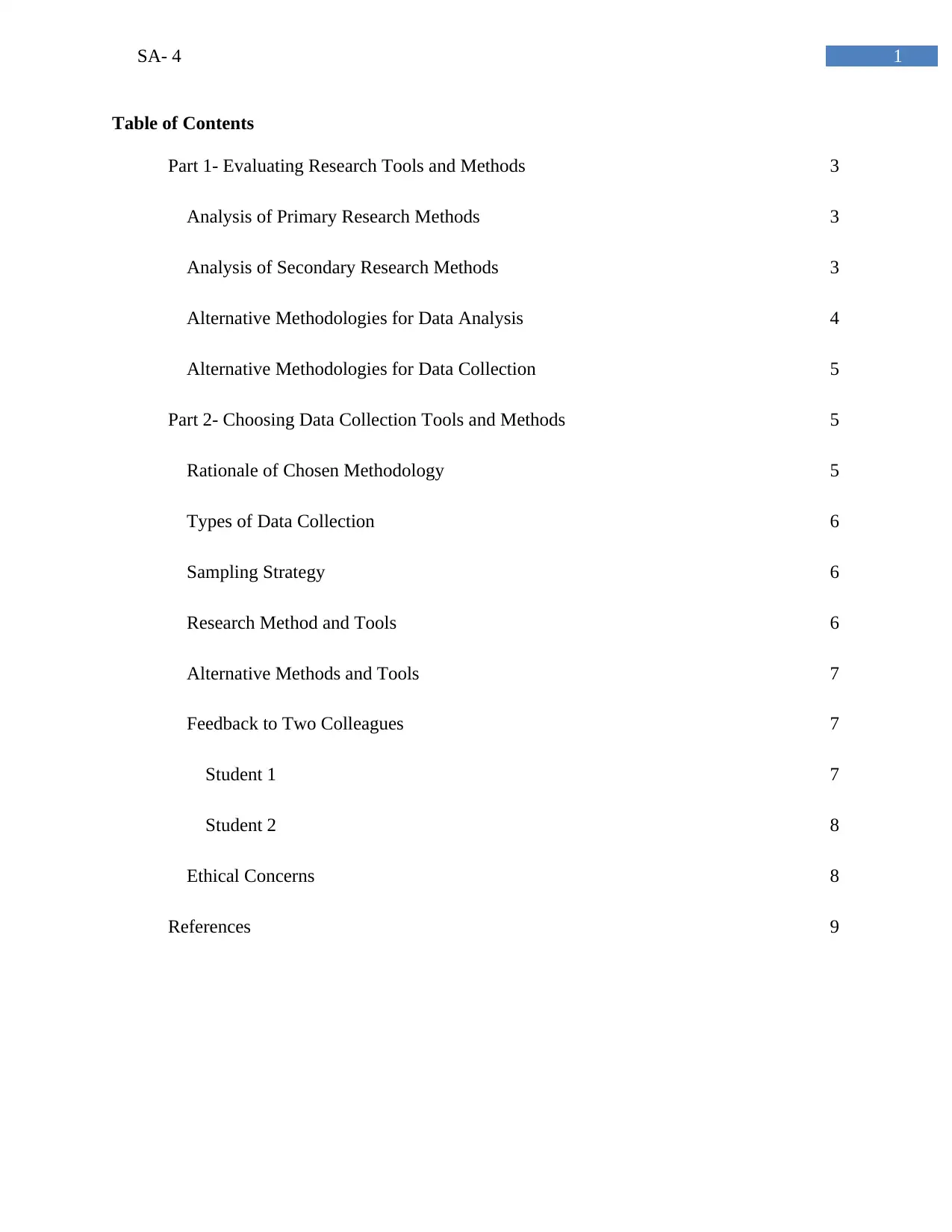
1SA- 4
Table of Contents
Part 1- Evaluating Research Tools and Methods 3
Analysis of Primary Research Methods 3
Analysis of Secondary Research Methods 3
Alternative Methodologies for Data Analysis 4
Alternative Methodologies for Data Collection 5
Part 2- Choosing Data Collection Tools and Methods 5
Rationale of Chosen Methodology 5
Types of Data Collection 6
Sampling Strategy 6
Research Method and Tools 6
Alternative Methods and Tools 7
Feedback to Two Colleagues 7
Student 1 7
Student 2 8
Ethical Concerns 8
References 9
Table of Contents
Part 1- Evaluating Research Tools and Methods 3
Analysis of Primary Research Methods 3
Analysis of Secondary Research Methods 3
Alternative Methodologies for Data Analysis 4
Alternative Methodologies for Data Collection 5
Part 2- Choosing Data Collection Tools and Methods 5
Rationale of Chosen Methodology 5
Types of Data Collection 6
Sampling Strategy 6
Research Method and Tools 6
Alternative Methods and Tools 7
Feedback to Two Colleagues 7
Student 1 7
Student 2 8
Ethical Concerns 8
References 9
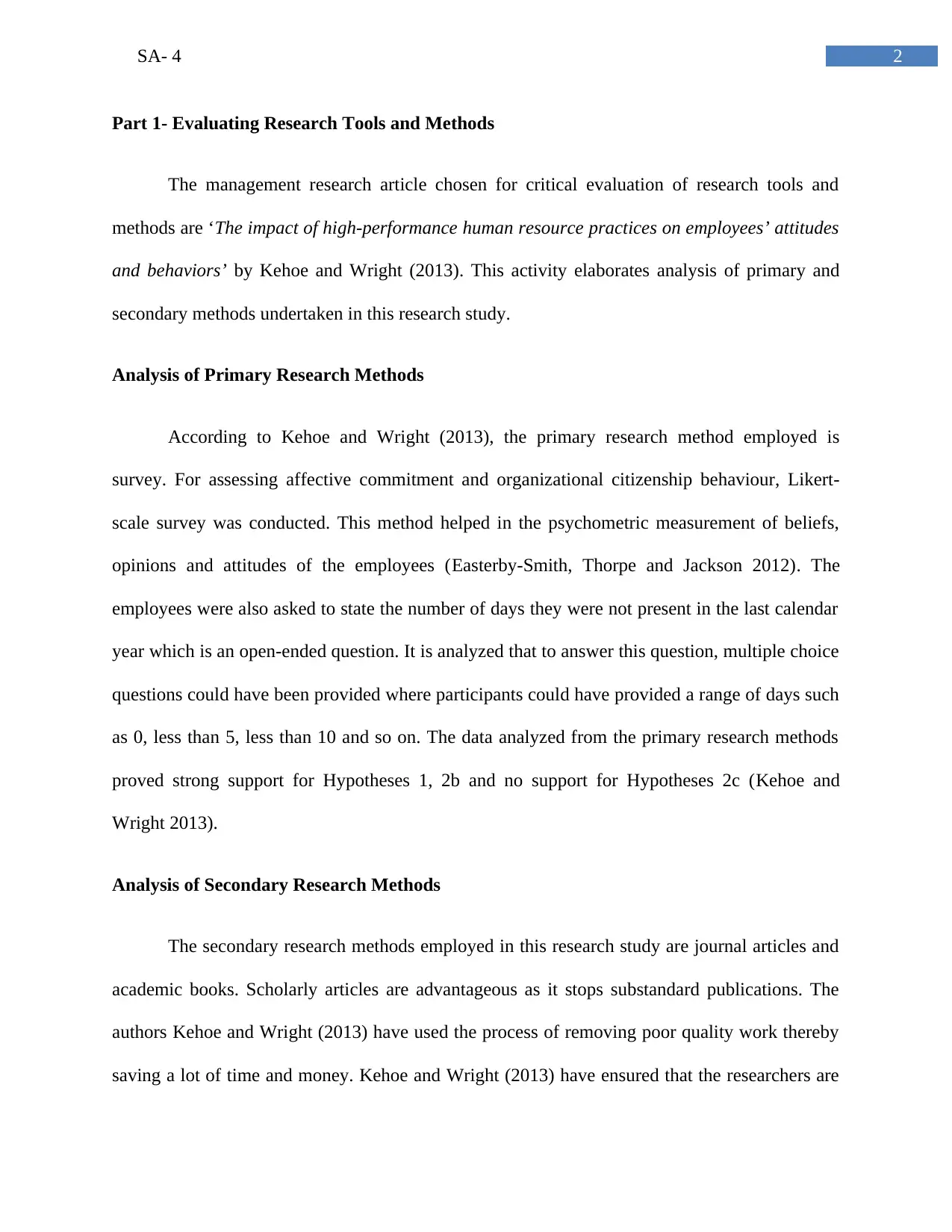
2SA- 4
Part 1- Evaluating Research Tools and Methods
The management research article chosen for critical evaluation of research tools and
methods are ‘The impact of high-performance human resource practices on employees’ attitudes
and behaviors’ by Kehoe and Wright (2013). This activity elaborates analysis of primary and
secondary methods undertaken in this research study.
Analysis of Primary Research Methods
According to Kehoe and Wright (2013), the primary research method employed is
survey. For assessing affective commitment and organizational citizenship behaviour, Likert-
scale survey was conducted. This method helped in the psychometric measurement of beliefs,
opinions and attitudes of the employees (Easterby-Smith, Thorpe and Jackson 2012). The
employees were also asked to state the number of days they were not present in the last calendar
year which is an open-ended question. It is analyzed that to answer this question, multiple choice
questions could have been provided where participants could have provided a range of days such
as 0, less than 5, less than 10 and so on. The data analyzed from the primary research methods
proved strong support for Hypotheses 1, 2b and no support for Hypotheses 2c (Kehoe and
Wright 2013).
Analysis of Secondary Research Methods
The secondary research methods employed in this research study are journal articles and
academic books. Scholarly articles are advantageous as it stops substandard publications. The
authors Kehoe and Wright (2013) have used the process of removing poor quality work thereby
saving a lot of time and money. Kehoe and Wright (2013) have ensured that the researchers are
Part 1- Evaluating Research Tools and Methods
The management research article chosen for critical evaluation of research tools and
methods are ‘The impact of high-performance human resource practices on employees’ attitudes
and behaviors’ by Kehoe and Wright (2013). This activity elaborates analysis of primary and
secondary methods undertaken in this research study.
Analysis of Primary Research Methods
According to Kehoe and Wright (2013), the primary research method employed is
survey. For assessing affective commitment and organizational citizenship behaviour, Likert-
scale survey was conducted. This method helped in the psychometric measurement of beliefs,
opinions and attitudes of the employees (Easterby-Smith, Thorpe and Jackson 2012). The
employees were also asked to state the number of days they were not present in the last calendar
year which is an open-ended question. It is analyzed that to answer this question, multiple choice
questions could have been provided where participants could have provided a range of days such
as 0, less than 5, less than 10 and so on. The data analyzed from the primary research methods
proved strong support for Hypotheses 1, 2b and no support for Hypotheses 2c (Kehoe and
Wright 2013).
Analysis of Secondary Research Methods
The secondary research methods employed in this research study are journal articles and
academic books. Scholarly articles are advantageous as it stops substandard publications. The
authors Kehoe and Wright (2013) have used the process of removing poor quality work thereby
saving a lot of time and money. Kehoe and Wright (2013) have ensured that the researchers are
⊘ This is a preview!⊘
Do you want full access?
Subscribe today to unlock all pages.

Trusted by 1+ million students worldwide
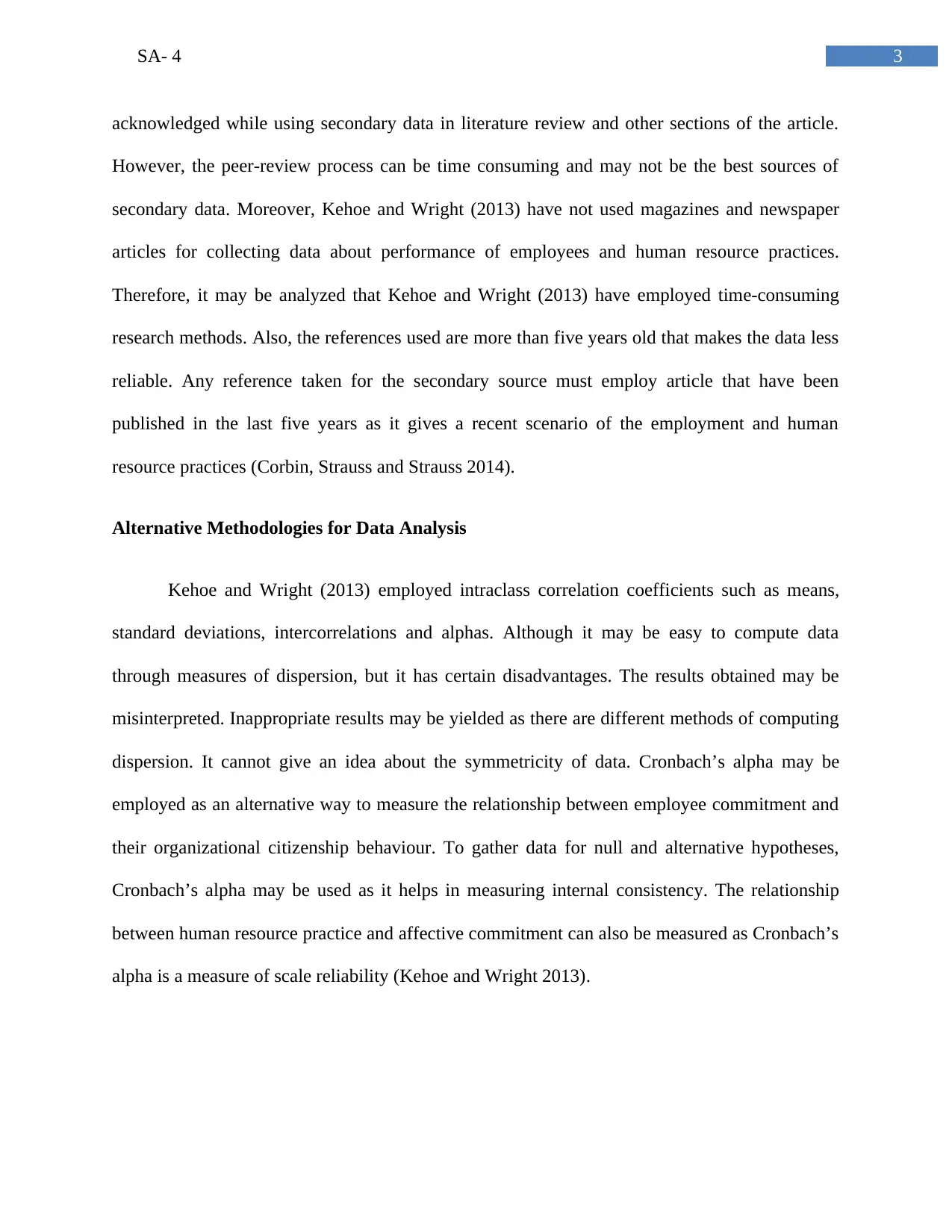
3SA- 4
acknowledged while using secondary data in literature review and other sections of the article.
However, the peer-review process can be time consuming and may not be the best sources of
secondary data. Moreover, Kehoe and Wright (2013) have not used magazines and newspaper
articles for collecting data about performance of employees and human resource practices.
Therefore, it may be analyzed that Kehoe and Wright (2013) have employed time-consuming
research methods. Also, the references used are more than five years old that makes the data less
reliable. Any reference taken for the secondary source must employ article that have been
published in the last five years as it gives a recent scenario of the employment and human
resource practices (Corbin, Strauss and Strauss 2014).
Alternative Methodologies for Data Analysis
Kehoe and Wright (2013) employed intraclass correlation coefficients such as means,
standard deviations, intercorrelations and alphas. Although it may be easy to compute data
through measures of dispersion, but it has certain disadvantages. The results obtained may be
misinterpreted. Inappropriate results may be yielded as there are different methods of computing
dispersion. It cannot give an idea about the symmetricity of data. Cronbach’s alpha may be
employed as an alternative way to measure the relationship between employee commitment and
their organizational citizenship behaviour. To gather data for null and alternative hypotheses,
Cronbach’s alpha may be used as it helps in measuring internal consistency. The relationship
between human resource practice and affective commitment can also be measured as Cronbach’s
alpha is a measure of scale reliability (Kehoe and Wright 2013).
acknowledged while using secondary data in literature review and other sections of the article.
However, the peer-review process can be time consuming and may not be the best sources of
secondary data. Moreover, Kehoe and Wright (2013) have not used magazines and newspaper
articles for collecting data about performance of employees and human resource practices.
Therefore, it may be analyzed that Kehoe and Wright (2013) have employed time-consuming
research methods. Also, the references used are more than five years old that makes the data less
reliable. Any reference taken for the secondary source must employ article that have been
published in the last five years as it gives a recent scenario of the employment and human
resource practices (Corbin, Strauss and Strauss 2014).
Alternative Methodologies for Data Analysis
Kehoe and Wright (2013) employed intraclass correlation coefficients such as means,
standard deviations, intercorrelations and alphas. Although it may be easy to compute data
through measures of dispersion, but it has certain disadvantages. The results obtained may be
misinterpreted. Inappropriate results may be yielded as there are different methods of computing
dispersion. It cannot give an idea about the symmetricity of data. Cronbach’s alpha may be
employed as an alternative way to measure the relationship between employee commitment and
their organizational citizenship behaviour. To gather data for null and alternative hypotheses,
Cronbach’s alpha may be used as it helps in measuring internal consistency. The relationship
between human resource practice and affective commitment can also be measured as Cronbach’s
alpha is a measure of scale reliability (Kehoe and Wright 2013).
Paraphrase This Document
Need a fresh take? Get an instant paraphrase of this document with our AI Paraphraser
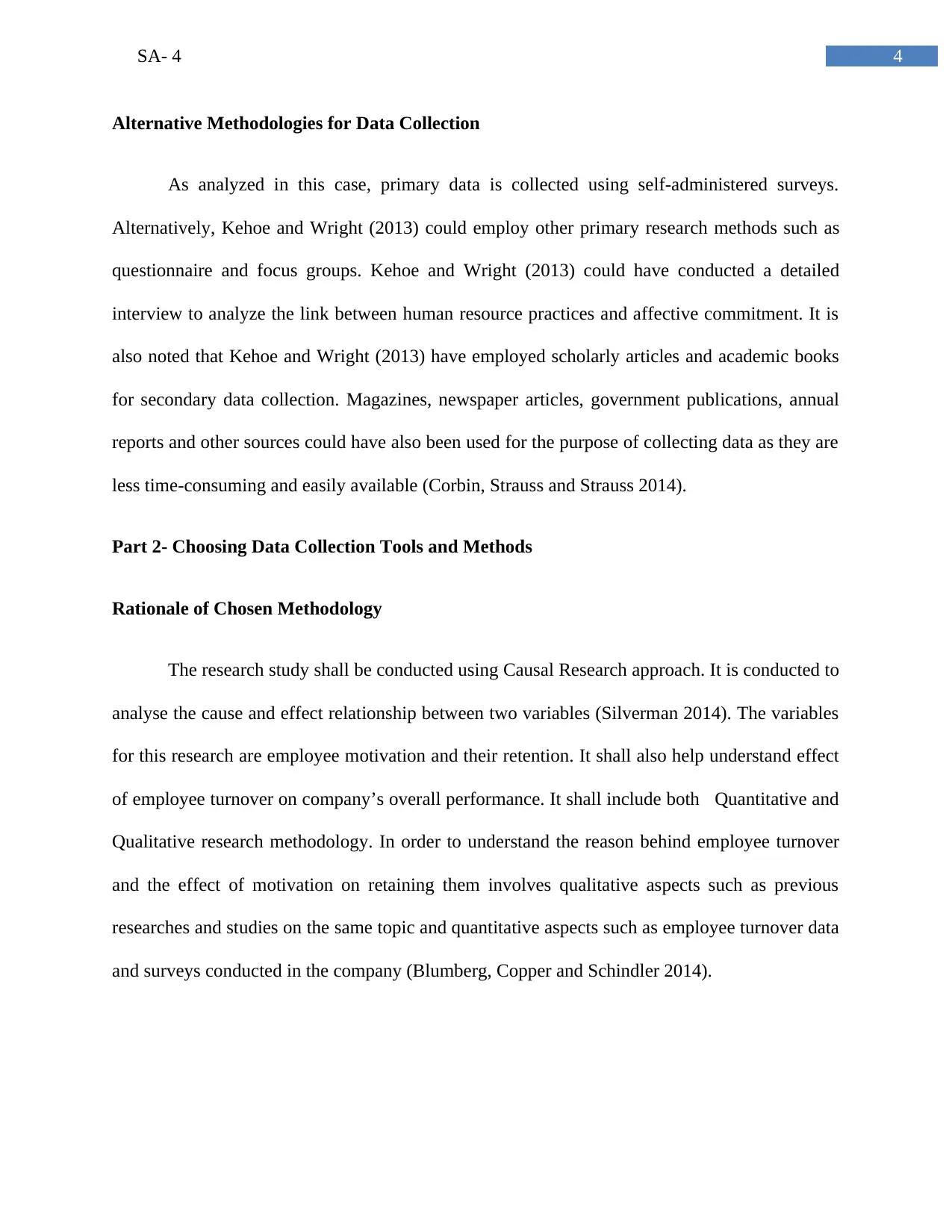
4SA- 4
Alternative Methodologies for Data Collection
As analyzed in this case, primary data is collected using self-administered surveys.
Alternatively, Kehoe and Wright (2013) could employ other primary research methods such as
questionnaire and focus groups. Kehoe and Wright (2013) could have conducted a detailed
interview to analyze the link between human resource practices and affective commitment. It is
also noted that Kehoe and Wright (2013) have employed scholarly articles and academic books
for secondary data collection. Magazines, newspaper articles, government publications, annual
reports and other sources could have also been used for the purpose of collecting data as they are
less time-consuming and easily available (Corbin, Strauss and Strauss 2014).
Part 2- Choosing Data Collection Tools and Methods
Rationale of Chosen Methodology
The research study shall be conducted using Causal Research approach. It is conducted to
analyse the cause and effect relationship between two variables (Silverman 2014). The variables
for this research are employee motivation and their retention. It shall also help understand effect
of employee turnover on company’s overall performance. It shall include both Quantitative and
Qualitative research methodology. In order to understand the reason behind employee turnover
and the effect of motivation on retaining them involves qualitative aspects such as previous
researches and studies on the same topic and quantitative aspects such as employee turnover data
and surveys conducted in the company (Blumberg, Copper and Schindler 2014).
Alternative Methodologies for Data Collection
As analyzed in this case, primary data is collected using self-administered surveys.
Alternatively, Kehoe and Wright (2013) could employ other primary research methods such as
questionnaire and focus groups. Kehoe and Wright (2013) could have conducted a detailed
interview to analyze the link between human resource practices and affective commitment. It is
also noted that Kehoe and Wright (2013) have employed scholarly articles and academic books
for secondary data collection. Magazines, newspaper articles, government publications, annual
reports and other sources could have also been used for the purpose of collecting data as they are
less time-consuming and easily available (Corbin, Strauss and Strauss 2014).
Part 2- Choosing Data Collection Tools and Methods
Rationale of Chosen Methodology
The research study shall be conducted using Causal Research approach. It is conducted to
analyse the cause and effect relationship between two variables (Silverman 2014). The variables
for this research are employee motivation and their retention. It shall also help understand effect
of employee turnover on company’s overall performance. It shall include both Quantitative and
Qualitative research methodology. In order to understand the reason behind employee turnover
and the effect of motivation on retaining them involves qualitative aspects such as previous
researches and studies on the same topic and quantitative aspects such as employee turnover data
and surveys conducted in the company (Blumberg, Copper and Schindler 2014).
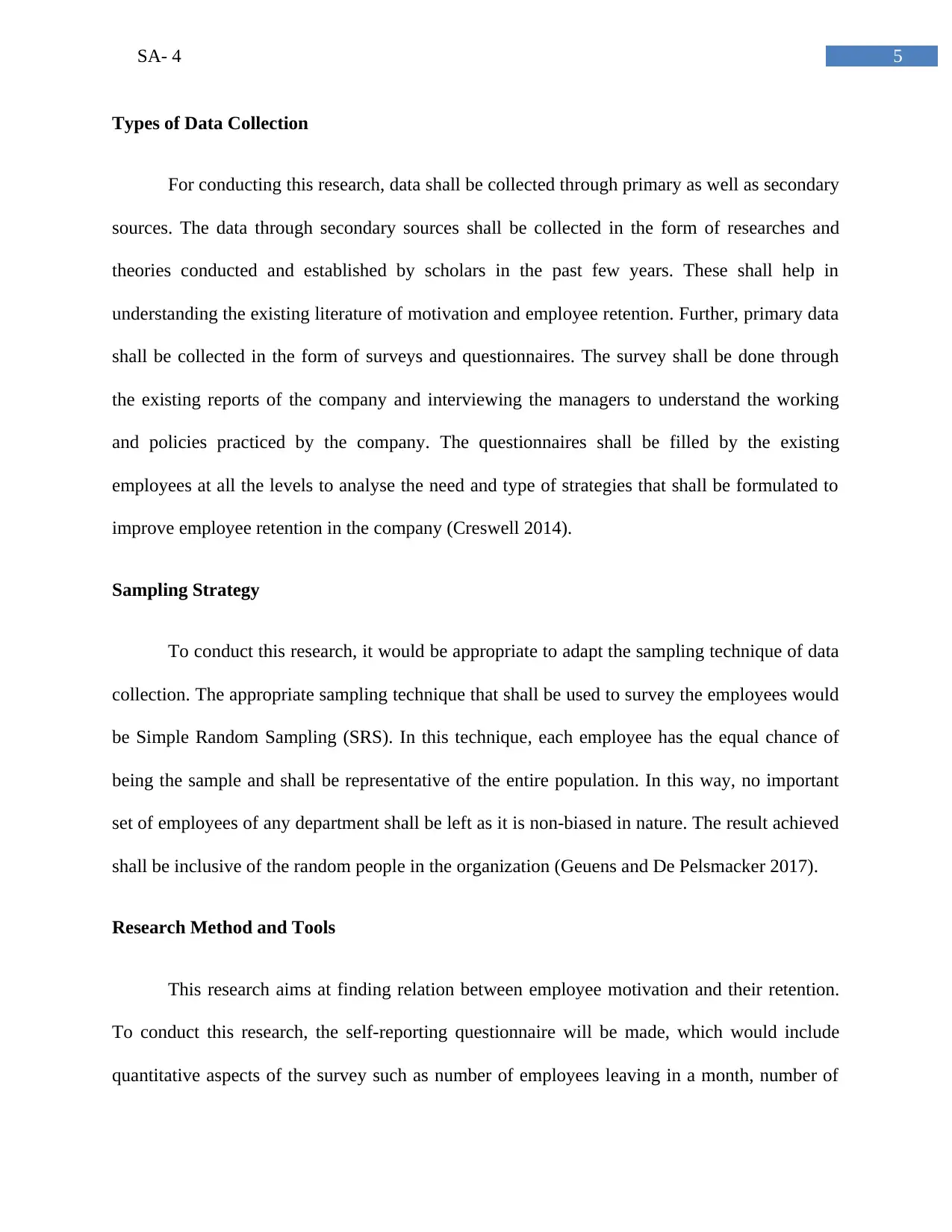
5SA- 4
Types of Data Collection
For conducting this research, data shall be collected through primary as well as secondary
sources. The data through secondary sources shall be collected in the form of researches and
theories conducted and established by scholars in the past few years. These shall help in
understanding the existing literature of motivation and employee retention. Further, primary data
shall be collected in the form of surveys and questionnaires. The survey shall be done through
the existing reports of the company and interviewing the managers to understand the working
and policies practiced by the company. The questionnaires shall be filled by the existing
employees at all the levels to analyse the need and type of strategies that shall be formulated to
improve employee retention in the company (Creswell 2014).
Sampling Strategy
To conduct this research, it would be appropriate to adapt the sampling technique of data
collection. The appropriate sampling technique that shall be used to survey the employees would
be Simple Random Sampling (SRS). In this technique, each employee has the equal chance of
being the sample and shall be representative of the entire population. In this way, no important
set of employees of any department shall be left as it is non-biased in nature. The result achieved
shall be inclusive of the random people in the organization (Geuens and De Pelsmacker 2017).
Research Method and Tools
This research aims at finding relation between employee motivation and their retention.
To conduct this research, the self-reporting questionnaire will be made, which would include
quantitative aspects of the survey such as number of employees leaving in a month, number of
Types of Data Collection
For conducting this research, data shall be collected through primary as well as secondary
sources. The data through secondary sources shall be collected in the form of researches and
theories conducted and established by scholars in the past few years. These shall help in
understanding the existing literature of motivation and employee retention. Further, primary data
shall be collected in the form of surveys and questionnaires. The survey shall be done through
the existing reports of the company and interviewing the managers to understand the working
and policies practiced by the company. The questionnaires shall be filled by the existing
employees at all the levels to analyse the need and type of strategies that shall be formulated to
improve employee retention in the company (Creswell 2014).
Sampling Strategy
To conduct this research, it would be appropriate to adapt the sampling technique of data
collection. The appropriate sampling technique that shall be used to survey the employees would
be Simple Random Sampling (SRS). In this technique, each employee has the equal chance of
being the sample and shall be representative of the entire population. In this way, no important
set of employees of any department shall be left as it is non-biased in nature. The result achieved
shall be inclusive of the random people in the organization (Geuens and De Pelsmacker 2017).
Research Method and Tools
This research aims at finding relation between employee motivation and their retention.
To conduct this research, the self-reporting questionnaire will be made, which would include
quantitative aspects of the survey such as number of employees leaving in a month, number of
⊘ This is a preview!⊘
Do you want full access?
Subscribe today to unlock all pages.

Trusted by 1+ million students worldwide
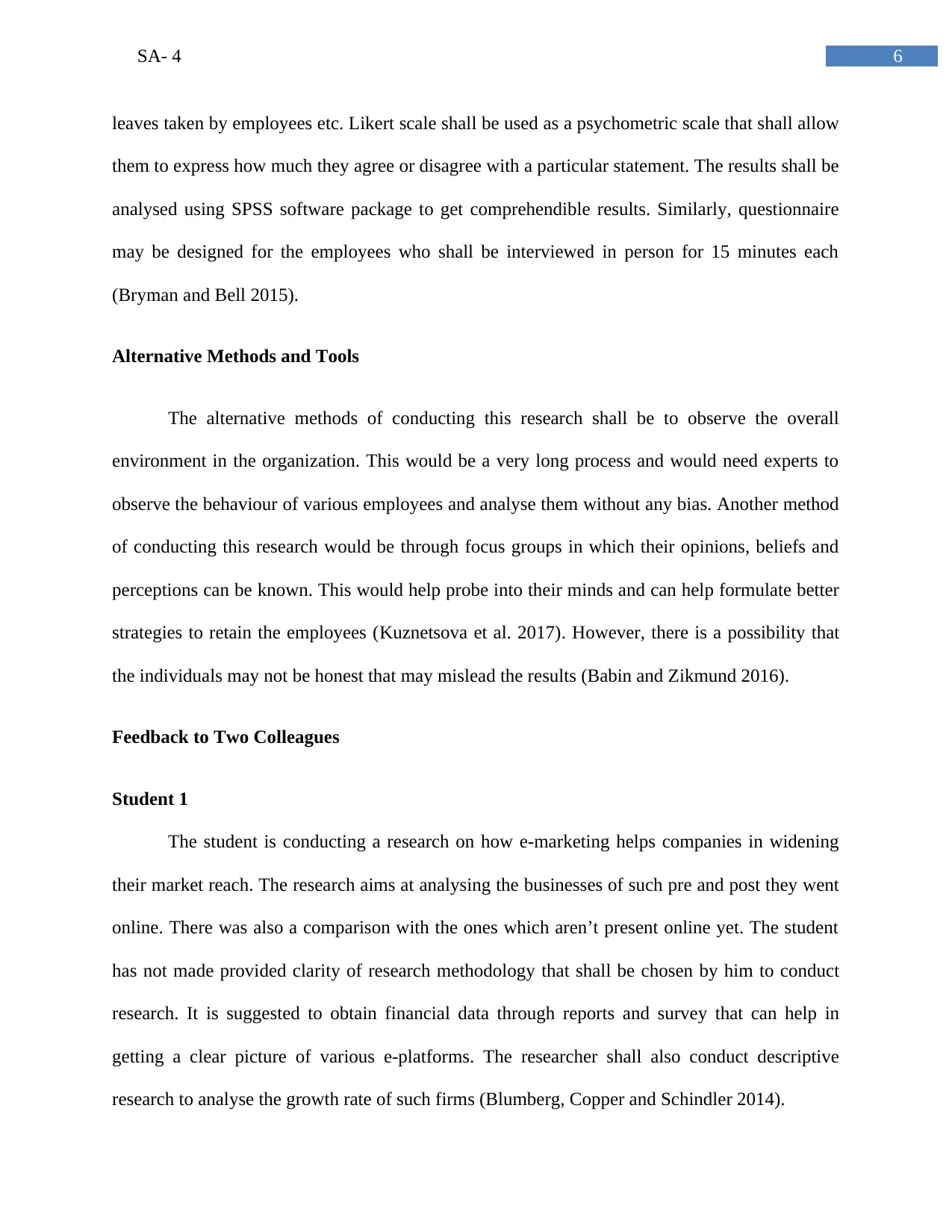
6SA- 4
leaves taken by employees etc. Likert scale shall be used as a psychometric scale that shall allow
them to express how much they agree or disagree with a particular statement. The results shall be
analysed using SPSS software package to get comprehendible results. Similarly, questionnaire
may be designed for the employees who shall be interviewed in person for 15 minutes each
(Bryman and Bell 2015).
Alternative Methods and Tools
The alternative methods of conducting this research shall be to observe the overall
environment in the organization. This would be a very long process and would need experts to
observe the behaviour of various employees and analyse them without any bias. Another method
of conducting this research would be through focus groups in which their opinions, beliefs and
perceptions can be known. This would help probe into their minds and can help formulate better
strategies to retain the employees (Kuznetsova et al. 2017). However, there is a possibility that
the individuals may not be honest that may mislead the results (Babin and Zikmund 2016).
Feedback to Two Colleagues
Student 1
The student is conducting a research on how e-marketing helps companies in widening
their market reach. The research aims at analysing the businesses of such pre and post they went
online. There was also a comparison with the ones which aren’t present online yet. The student
has not made provided clarity of research methodology that shall be chosen by him to conduct
research. It is suggested to obtain financial data through reports and survey that can help in
getting a clear picture of various e-platforms. The researcher shall also conduct descriptive
research to analyse the growth rate of such firms (Blumberg, Copper and Schindler 2014).
leaves taken by employees etc. Likert scale shall be used as a psychometric scale that shall allow
them to express how much they agree or disagree with a particular statement. The results shall be
analysed using SPSS software package to get comprehendible results. Similarly, questionnaire
may be designed for the employees who shall be interviewed in person for 15 minutes each
(Bryman and Bell 2015).
Alternative Methods and Tools
The alternative methods of conducting this research shall be to observe the overall
environment in the organization. This would be a very long process and would need experts to
observe the behaviour of various employees and analyse them without any bias. Another method
of conducting this research would be through focus groups in which their opinions, beliefs and
perceptions can be known. This would help probe into their minds and can help formulate better
strategies to retain the employees (Kuznetsova et al. 2017). However, there is a possibility that
the individuals may not be honest that may mislead the results (Babin and Zikmund 2016).
Feedback to Two Colleagues
Student 1
The student is conducting a research on how e-marketing helps companies in widening
their market reach. The research aims at analysing the businesses of such pre and post they went
online. There was also a comparison with the ones which aren’t present online yet. The student
has not made provided clarity of research methodology that shall be chosen by him to conduct
research. It is suggested to obtain financial data through reports and survey that can help in
getting a clear picture of various e-platforms. The researcher shall also conduct descriptive
research to analyse the growth rate of such firms (Blumberg, Copper and Schindler 2014).
Paraphrase This Document
Need a fresh take? Get an instant paraphrase of this document with our AI Paraphraser
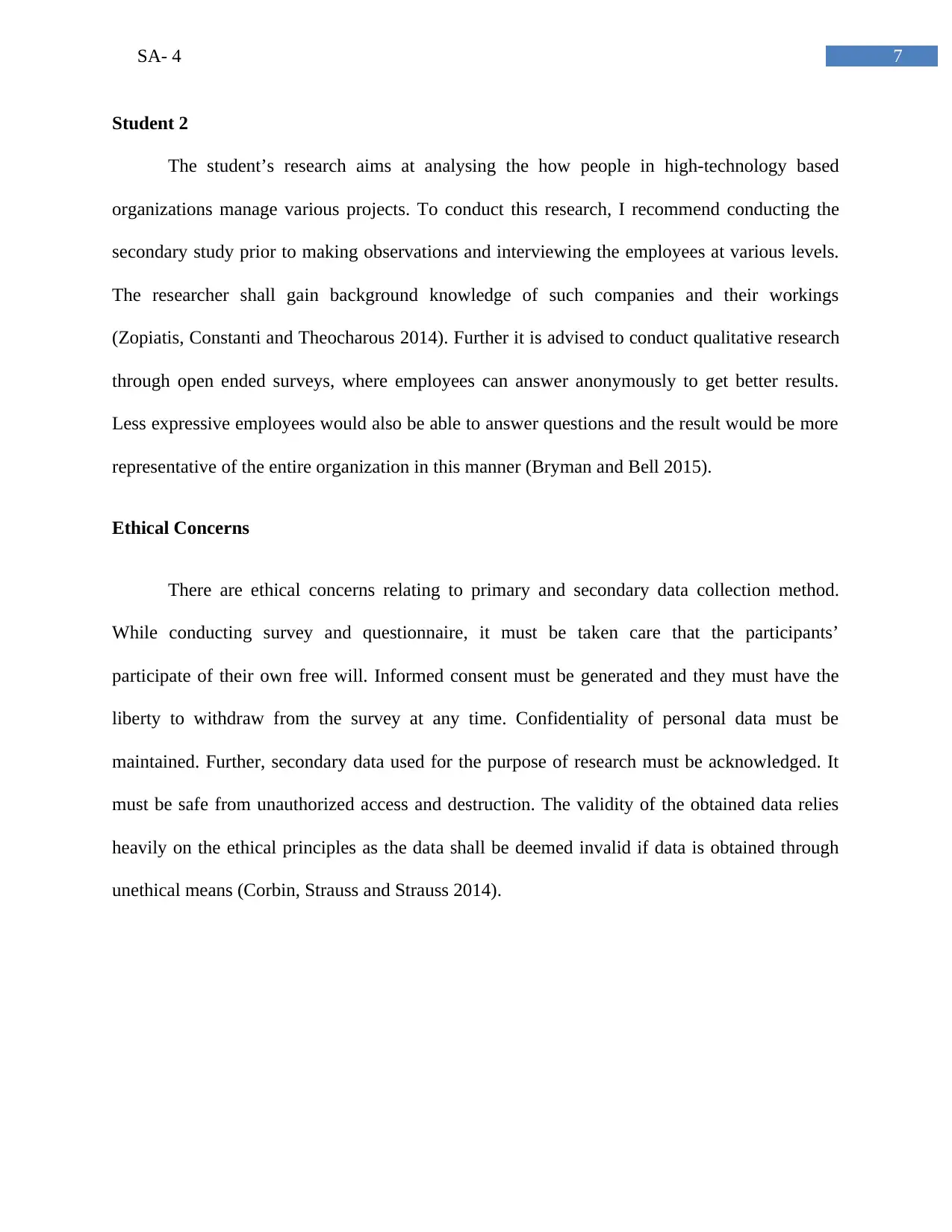
7SA- 4
Student 2
The student’s research aims at analysing the how people in high-technology based
organizations manage various projects. To conduct this research, I recommend conducting the
secondary study prior to making observations and interviewing the employees at various levels.
The researcher shall gain background knowledge of such companies and their workings
(Zopiatis, Constanti and Theocharous 2014). Further it is advised to conduct qualitative research
through open ended surveys, where employees can answer anonymously to get better results.
Less expressive employees would also be able to answer questions and the result would be more
representative of the entire organization in this manner (Bryman and Bell 2015).
Ethical Concerns
There are ethical concerns relating to primary and secondary data collection method.
While conducting survey and questionnaire, it must be taken care that the participants’
participate of their own free will. Informed consent must be generated and they must have the
liberty to withdraw from the survey at any time. Confidentiality of personal data must be
maintained. Further, secondary data used for the purpose of research must be acknowledged. It
must be safe from unauthorized access and destruction. The validity of the obtained data relies
heavily on the ethical principles as the data shall be deemed invalid if data is obtained through
unethical means (Corbin, Strauss and Strauss 2014).
Student 2
The student’s research aims at analysing the how people in high-technology based
organizations manage various projects. To conduct this research, I recommend conducting the
secondary study prior to making observations and interviewing the employees at various levels.
The researcher shall gain background knowledge of such companies and their workings
(Zopiatis, Constanti and Theocharous 2014). Further it is advised to conduct qualitative research
through open ended surveys, where employees can answer anonymously to get better results.
Less expressive employees would also be able to answer questions and the result would be more
representative of the entire organization in this manner (Bryman and Bell 2015).
Ethical Concerns
There are ethical concerns relating to primary and secondary data collection method.
While conducting survey and questionnaire, it must be taken care that the participants’
participate of their own free will. Informed consent must be generated and they must have the
liberty to withdraw from the survey at any time. Confidentiality of personal data must be
maintained. Further, secondary data used for the purpose of research must be acknowledged. It
must be safe from unauthorized access and destruction. The validity of the obtained data relies
heavily on the ethical principles as the data shall be deemed invalid if data is obtained through
unethical means (Corbin, Strauss and Strauss 2014).
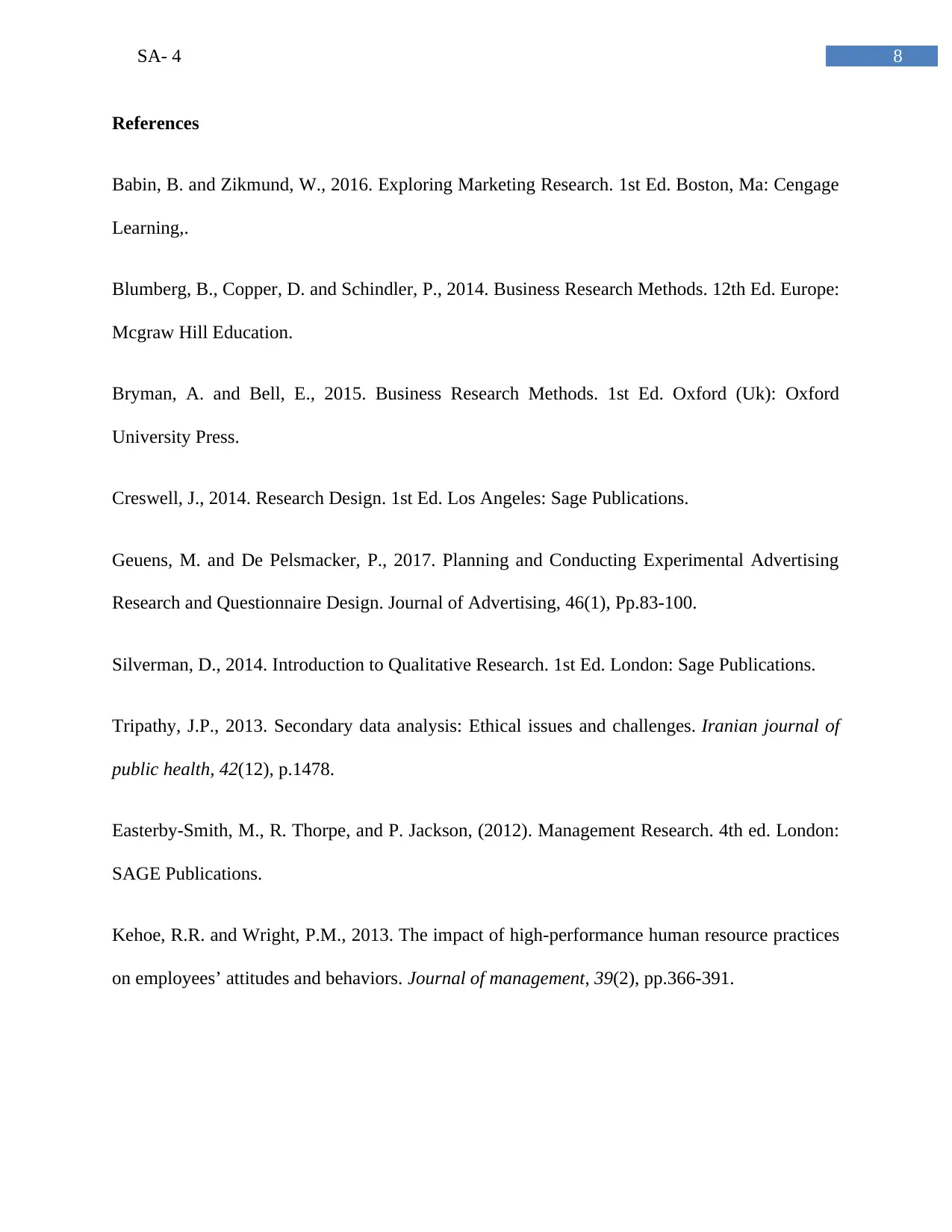
8SA- 4
References
Babin, B. and Zikmund, W., 2016. Exploring Marketing Research. 1st Ed. Boston, Ma: Cengage
Learning,.
Blumberg, B., Copper, D. and Schindler, P., 2014. Business Research Methods. 12th Ed. Europe:
Mcgraw Hill Education.
Bryman, A. and Bell, E., 2015. Business Research Methods. 1st Ed. Oxford (Uk): Oxford
University Press.
Creswell, J., 2014. Research Design. 1st Ed. Los Angeles: Sage Publications.
Geuens, M. and De Pelsmacker, P., 2017. Planning and Conducting Experimental Advertising
Research and Questionnaire Design. Journal of Advertising, 46(1), Pp.83-100.
Silverman, D., 2014. Introduction to Qualitative Research. 1st Ed. London: Sage Publications.
Tripathy, J.P., 2013. Secondary data analysis: Ethical issues and challenges. Iranian journal of
public health, 42(12), p.1478.
Easterby-Smith, M., R. Thorpe, and P. Jackson, (2012). Management Research. 4th ed. London:
SAGE Publications.
Kehoe, R.R. and Wright, P.M., 2013. The impact of high-performance human resource practices
on employees’ attitudes and behaviors. Journal of management, 39(2), pp.366-391.
References
Babin, B. and Zikmund, W., 2016. Exploring Marketing Research. 1st Ed. Boston, Ma: Cengage
Learning,.
Blumberg, B., Copper, D. and Schindler, P., 2014. Business Research Methods. 12th Ed. Europe:
Mcgraw Hill Education.
Bryman, A. and Bell, E., 2015. Business Research Methods. 1st Ed. Oxford (Uk): Oxford
University Press.
Creswell, J., 2014. Research Design. 1st Ed. Los Angeles: Sage Publications.
Geuens, M. and De Pelsmacker, P., 2017. Planning and Conducting Experimental Advertising
Research and Questionnaire Design. Journal of Advertising, 46(1), Pp.83-100.
Silverman, D., 2014. Introduction to Qualitative Research. 1st Ed. London: Sage Publications.
Tripathy, J.P., 2013. Secondary data analysis: Ethical issues and challenges. Iranian journal of
public health, 42(12), p.1478.
Easterby-Smith, M., R. Thorpe, and P. Jackson, (2012). Management Research. 4th ed. London:
SAGE Publications.
Kehoe, R.R. and Wright, P.M., 2013. The impact of high-performance human resource practices
on employees’ attitudes and behaviors. Journal of management, 39(2), pp.366-391.
⊘ This is a preview!⊘
Do you want full access?
Subscribe today to unlock all pages.

Trusted by 1+ million students worldwide
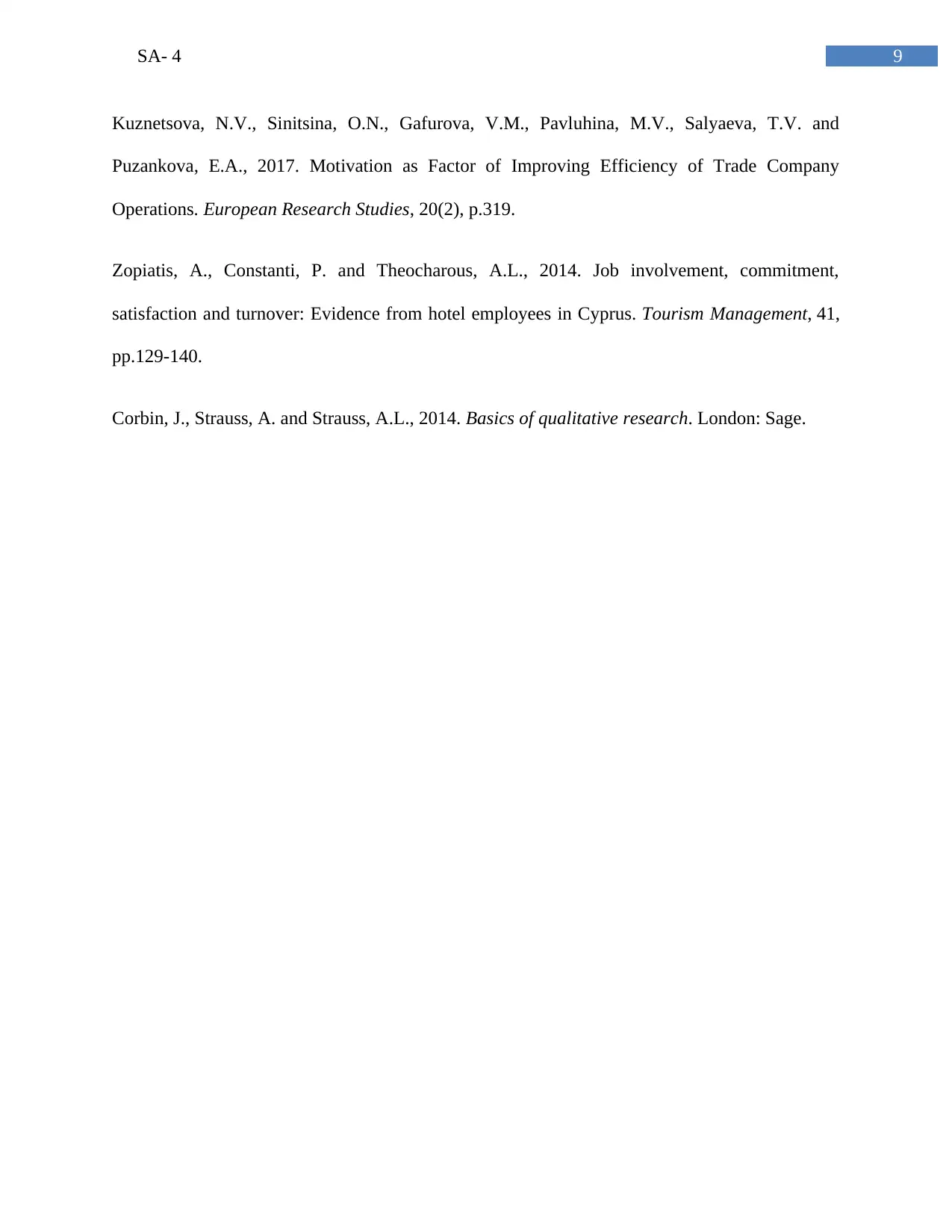
9SA- 4
Kuznetsova, N.V., Sinitsina, O.N., Gafurova, V.M., Pavluhina, M.V., Salyaeva, T.V. and
Puzankova, E.A., 2017. Motivation as Factor of Improving Efficiency of Trade Company
Operations. European Research Studies, 20(2), p.319.
Zopiatis, A., Constanti, P. and Theocharous, A.L., 2014. Job involvement, commitment,
satisfaction and turnover: Evidence from hotel employees in Cyprus. Tourism Management, 41,
pp.129-140.
Corbin, J., Strauss, A. and Strauss, A.L., 2014. Basics of qualitative research. London: Sage.
Kuznetsova, N.V., Sinitsina, O.N., Gafurova, V.M., Pavluhina, M.V., Salyaeva, T.V. and
Puzankova, E.A., 2017. Motivation as Factor of Improving Efficiency of Trade Company
Operations. European Research Studies, 20(2), p.319.
Zopiatis, A., Constanti, P. and Theocharous, A.L., 2014. Job involvement, commitment,
satisfaction and turnover: Evidence from hotel employees in Cyprus. Tourism Management, 41,
pp.129-140.
Corbin, J., Strauss, A. and Strauss, A.L., 2014. Basics of qualitative research. London: Sage.
1 out of 10
Related Documents
Your All-in-One AI-Powered Toolkit for Academic Success.
+13062052269
info@desklib.com
Available 24*7 on WhatsApp / Email
![[object Object]](/_next/static/media/star-bottom.7253800d.svg)
Unlock your academic potential
Copyright © 2020–2025 A2Z Services. All Rights Reserved. Developed and managed by ZUCOL.





